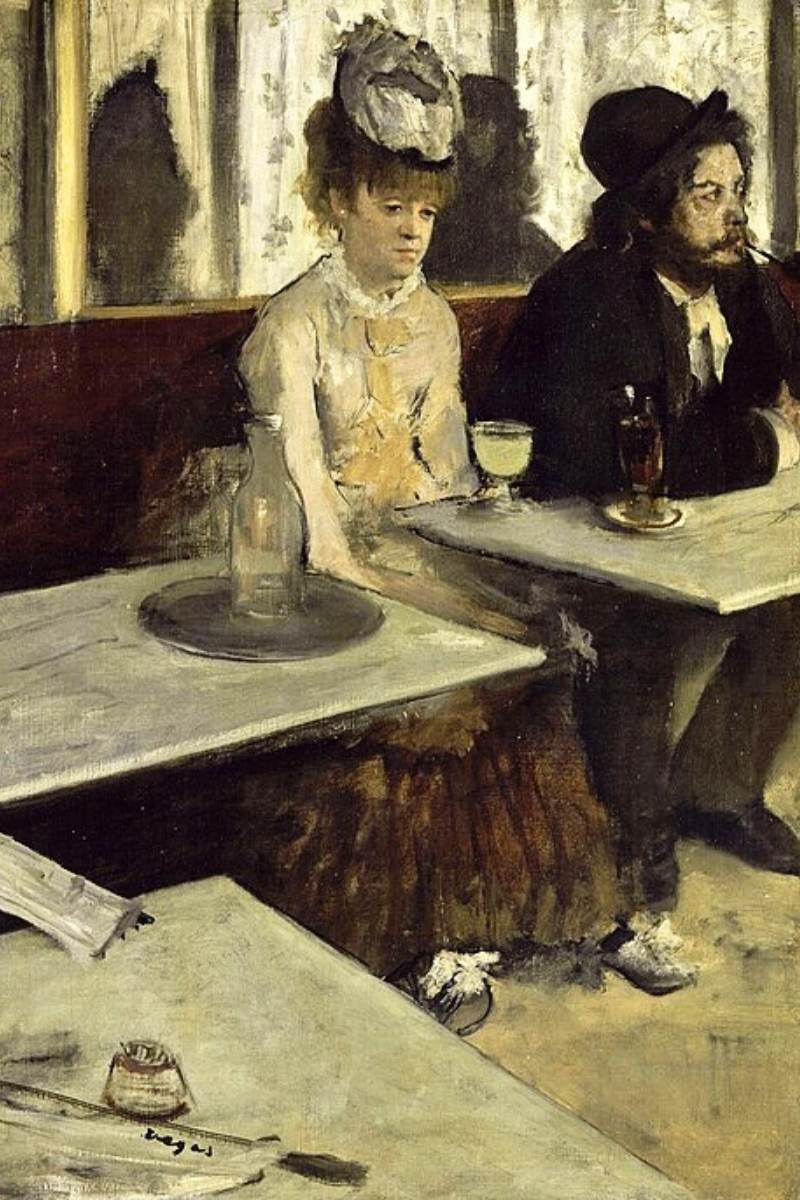Paris, Musée d’Orsay
Absinthe, called the ‘green fairy’, was a popular drink among the working class in Degas’ day, despite its devastating effects, which Degas more than hints at in this painting. A woman slouches, sadness on all her features, her eyes glazed, staring into space, moving towards the oblivion of her next glass of absinthe. The glass, filled with milky green liquid, looks a bit like a magic potion and her limp arms and splayed feet suggest this is not her first. The man besides her sits in the relaxed yet attentive pose of the café habitué, watching the world go by with bloodshot eyes as he nurses a Mazagran, a noted hangover remedy. Behind each drinker their blurry shadows in the long mirror echo their lonely, semi-conscious isolation.
This was a scene Degas, himself a frequent patron of Paris cafes, had probably seen many times. The café depicted is one of Degas’ preferred meeting places, ‘La Nouvelle Athènes’ on Place Pigalle in Montmartre, a hot spot for artists and bohemian intellectuals; Courbet, Gambetta and Manet were among its clientele. This particular scene, however, was staged: the two drinkers are Degas’ friends, Ellen Andrée, a star of the Folies-Bergère and an artist’s model and Marcellin Desboutin, a fellow painter, whom Degas asked to pose for the painting. So successful was Degas in capturing the abyss of absinthe that rumours spread about Andrée and Desboutin and Degas had to publicly state that they were not alcoholics.
Unlike many of his Impressionist friends, Degas loved to paint urban subjects; places like La Nouvelle Athènes where Parisians of all classes gathered. He made sketches in situ but when it came to producing the finished painting, Degas worked alone in his studio and with discipline. ‘I assure you’, Degas said when asked about technique, ‘no art is less spontaneous than mine. What I do is the result of reflection and study of the Old Masters. Of inspiration, spontaneity, temperament… I know nothing’. He constantly reworked his pictures, trying to find the exact mood, movement and composition. But Degas’ genius was his ability to give his exacting experimentations and rigorous draughtsmanship the feeling of the real world, as he does with great success here.
The foreground is laid out like a zig-zag of marble table tops – without legs – which focuses attention on the two figures in the top right corner. Degas suggests the space rather than constructing it. The unusual off-centre framing, the empty spaces and the cutting off of the man’s pipe were inspired by Japanese prints, which favoured unexpected viewpoints and were all the rage in Parisian art circles. Here Degas uses these effects to suggest the inebriated haze of the drinkers. The framing also gives the impression of a snapshot taken from a nearby table or the view of a passer-by who glances in the café window, adding a voyeuristic element. It is like a scene from a novel; in fact Emile Zola told Degas that his novel L’Assommoir (The Drunkard), had drawn on Degas’ painting: ‘I quite plainly described some of your pictures in more than one place in my pages’.
Degas once said he wished to make ‘portraits of people in typical familiar poses… paying particular attention to making their faces as expressive as their bodies’. In this, Degas’ most famous café painting, the artist lives up to his ambitions.
Contemporary Works
1875 Henri Fantin-Latour: Mr and Mrs Edwin Edwards, London, Tate
1876 Edward Burne-Jones: The Mirror of Venus, Lisbon, Calouste Gulbenkian Museum
1876 Gustave Moreau: Hercules and the Lernaean Hydra, Chicago, Art Institute
Categories:
- Impressionism

